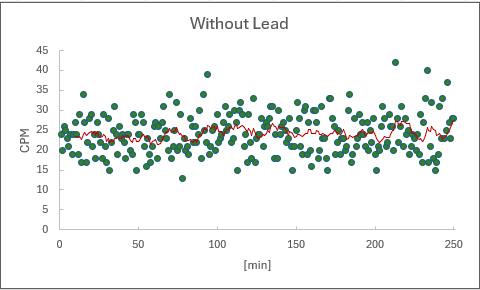| Difficult | Execution Time | Data Analysis | Radioactive Sources |
|---|---|---|---|
| Yes | No |
Hardware setup
This experiment guide is referred to the SP5660 Educational Kit.
Equipment: SP5660 – RockyRAD
| Model | SP5660 |
|---|---|
| Description | RockyRAD |
Purpose of the experiment
The experiment aims to analyze the impact of lead shielding on the environmental background particles detected by the GM detector.
Fundamentals
For precise spectral measurements, resolution in energy and signal-to-noise ratio are the key parameters. Therefore, it is crucial to shi

Experimental setup block diagram.
eld the detector with lead to minimize background. Lead is the most widely used material for shielding due to its high density and atomic number. The photoelectric absorption cross-section predominates at energies above 0.5 MeV, making it effective in easily absorbing relatively hard external background gamma rays (such as those at 1.46 MeV from 40K). Owing to its high density, thin layers of a few centimeters of Pb significantly reduce background for typical gamma-ray detectors. Additionally, it can eliminate many components of cosmic rays, although thicknesses of about 10 cm contribute to the background with secondary radiation due to cosmic interaction with the lead itself. It is often used in the form of rectangular “bricks.” Common lead exhibits a notable level of natural radioactivity; if refined, it may still contain 210Pb, a product of the decay of 226Ra, with a half-life of 20.4 years. While some types of Pb exhibit an activity of around 1.5 Bq/g, more refined lead is an order of magnitude or two below this value.
Carrying out the experiment
The experiment involves two data-taking phases: one with lead blocks covering and one without. Begin by placing the GM detector on the desk and powering on the system. The GM detector will immediately initiate measurements and record data every minute during acquisition. Background counts, essential for calibration, should be obtained in the absence of samples, specifically with the GM tube window uncovered. It is advisable to conduct a background acquisition for a minimum of 2 hours.
Upon completing the background measurement, cover the GM detector entirely with lead blocks. Maintain the same acquisition time to facilitate straightforward background subtraction.
Results
The user can easily check how lead blocks reduce the gamma radioactivity from the background, by comparing the results obtained by GM detector with and without lead blocks. The subsequent results illustrate how the mean counts per minute (CPM) decrease from approximately 24 to around 15 when lead shielding is employed.




